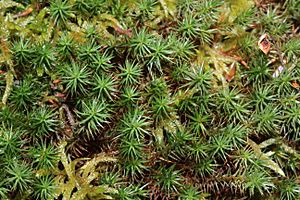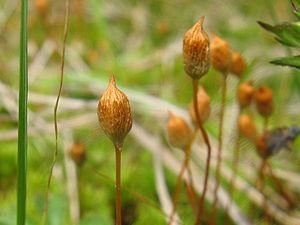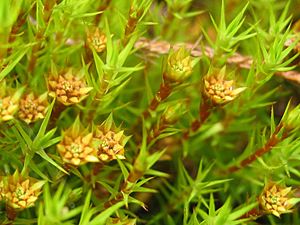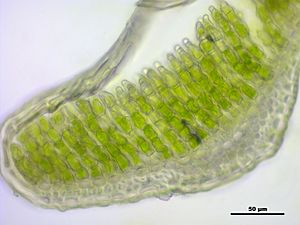Bog haircap moss facts for kids
Quick facts for kids Bog haircap moss |
|
|---|---|
 |
|
| Scientific classification | |
| Genus: |
Polytrichum
|
| Species: |
strictum
|
Polytrichum strictum, also known as bog haircap moss or strict haircap, is a type of moss. It stays green all year round and lives for many years. You can find it in wet places like Sphagnum bogs. It grows in cool areas around the world, including South America and Antarctica.
Contents
What Does Bog Haircap Moss Look Like?
Like other mosses in its family, Polytrichum strictum has special leaves. These leaves have a single strong vein down the middle. They also have tiny vertical plates called lamellae that help them collect water. A waxy layer on the outside helps keep water in.
This moss often grows in thick clumps of thin stems. These stems are usually 6 to 12 centimeters tall. They can form large bumps, or hummocks, up to 40 centimeters high in bogs. When the moss is dry, its leaves lie flat against the stem. When it's wet, they spread out.
P. strictum has reddish tips on its leaves and smooth, curled-in edges. These features help tell it apart from other mosses. Another moss, juniper haircap moss (P. juniperinum), looks similar. However, P. strictum has fuzzy, white root-like structures called rhizoids that grow up its stems. P. juniperinum does not have these. Also, P. strictum prefers wet, organic soils in bogs, while P. juniperinum often grows in drier, more disturbed areas.
Where Does Bog Haircap Moss Grow?
You can find Polytrichum strictum in many parts of the world. It grows across Canada, the northern United States, Greenland, Iceland, and northern Europe and Asia. It also lives in Antarctica and the southern part of South America.
This moss loves boggy areas where Sphagnum mosses are common. But it can also grow in wet heaths, cold tundra regions, and even peaty forests. In warmer places, it mostly sticks to old bogs. It usually grows on top of peat hummocks, which are small hills of decaying plant matter. It often helps to build these hummocks itself.
How Does Bog Haircap Moss Reproduce?

Polytrichum strictum has separate male and female plants. These plants are called gametophytes. They have only one set of chromosomes (haploid).
On male plants, special structures called antheridia produce sperm. These antheridia are found at the very top of the plant. When they are ready, they swell and burst, releasing sperm into the air. The male plants also have "splash cups." These cups catch raindrops, which then splash the sperm even further away.
If a sperm lands near a female plant, it uses its two tiny tails (flagella) to swim. It swims down a tube-like structure called an archegonia (found at the top of the female plant). Inside, it fertilizes an egg cell.
After fertilization, the fertilized egg grows into a new part of the moss called a sporophyte. This sporophyte has two sets of chromosomes (diploid). It has a foot that stays in the female plant, a stalk (seta), and a capsule. The capsule is covered by a dirty-white cap called a calyptra.
When the stalk grows long, the calyptra falls off. Inside the capsule, special cells divide through a process called meiosis. This creates four tiny spores, each with one set of chromosomes. When the spores are ready, a lid on the capsule (called an operculum) pops off. The spores are then released through a ring of 64 teeth.
If the spores land in the right place with good conditions, they start to grow. They first form a tiny, thread-like structure called a protonema. From this protonema, new gametophyte plants grow, and the whole life cycle starts again!
Why Is Bog Haircap Moss Important?
Polytrichum strictum is an important pioneer species in peatlands. This means it's one of the first plants to grow in new or disturbed areas. It can handle many different environmental conditions.
This moss is very helpful in preventing frost heaving in peatlands where peat has been harvested. Frost heaving happens when the ground freezes and thaws, pushing things up. P. strictum helps keep the soil stable. Scientists are studying if it can be used to help bring back unstable peat areas. They are also trying to learn if it helps or hinders the growth of Sphagnum mosses.



